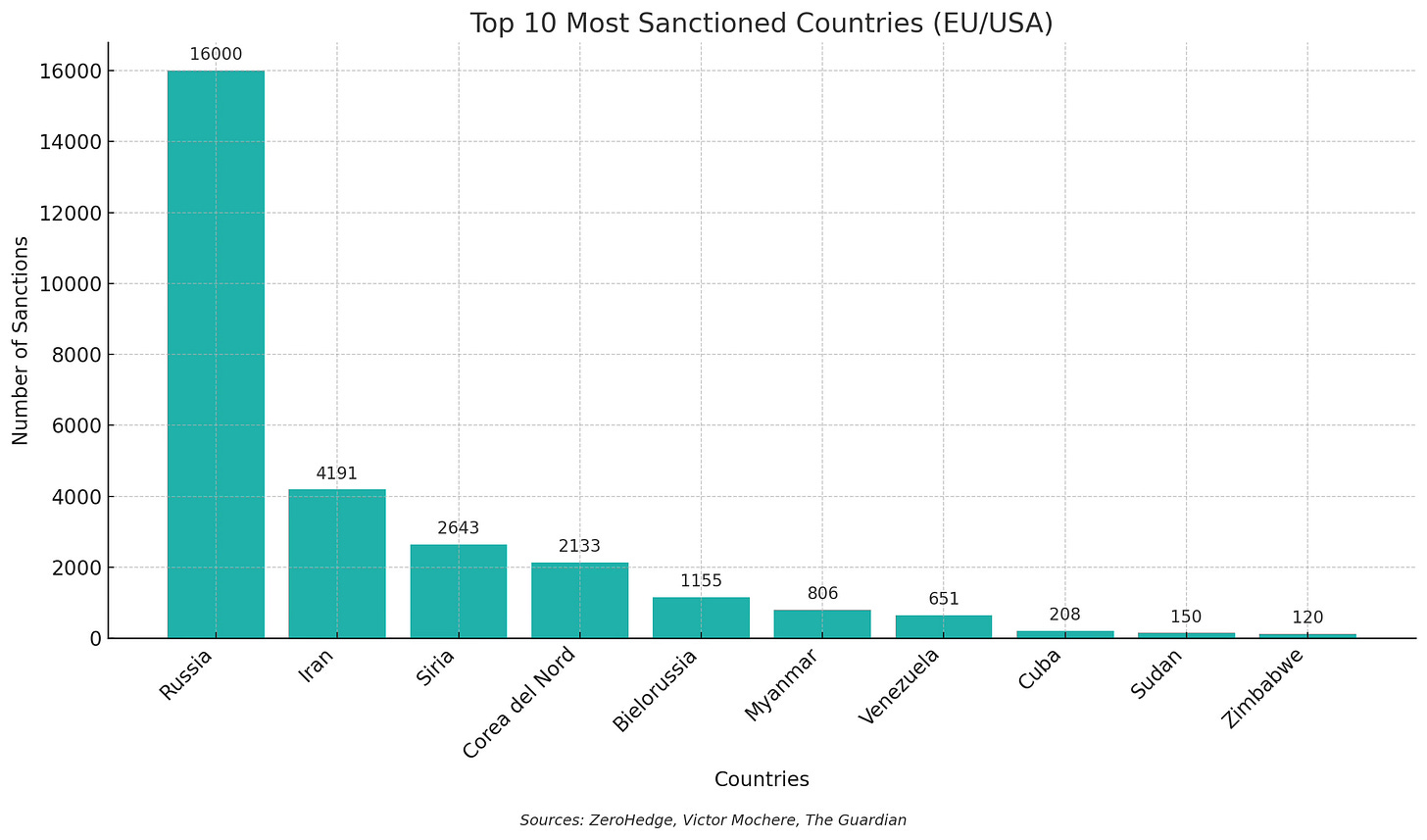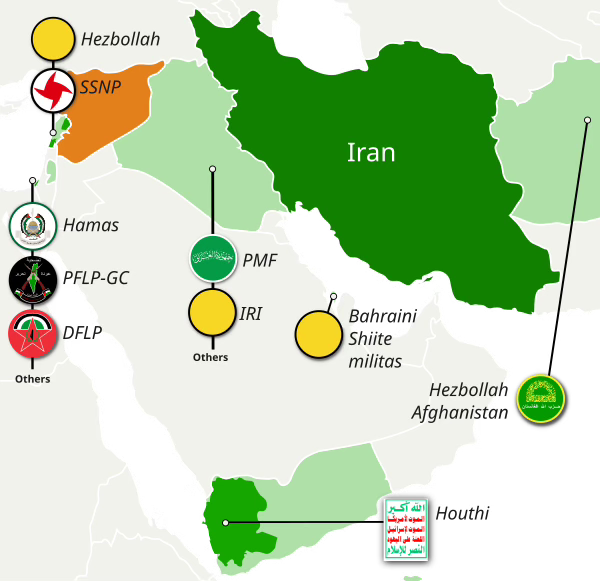The New Enemies of the Free World Are No Joke.
For far too many years, we’ve underestimated the threats posed by these nations.

So, here’s the point:
If you have even a slight interest in history, you'll know that distinct factions at war with each other have always existed.
From the dawn of time, there’s always been a "us versus them" mentality, and our current era is no exception.
In the past, the enemy was Nazi Germany, Fascist Italy, and the Japanese Empire.
Then it was the Russians and their Soviet Union.
After that came the Vietnamese.
Then the Iraqis and Saddam Hussein.
Al-Qaeda and ISIS (Daesh)…
So, who are the enemies of the West today? The enemies of the free world?
What are we doing to keep them in check?
Stay with me, because I’m convinced that the wars in Palestine and Ukraine are connected, and I want to explain why I believe that.
Before we begin, I want to thank you for opening and reading this article.
If you find my work valuable, I encourage you to subscribe for free to motivate me to keep writing.
I’m Simone, and now let’s get to the point.
Table of content:
The Enemies of the West and How They Collaborate.
Iran and North Korea’s Involvement in Ukraine.
How North Koreans are helping Iranians develop their nuclear program.
Iranian Oil Under Sanctions, Sold Under the Table to the Chinese.
How We’re Dealing with the Crisis.
The Enemies of the West and How They Collaborate.
We all know the infamous "Rogue States":
A group of countries, which has evolved over time, united by their tendency to create insecurity and destabilize peace in the world — or, more precisely, the peace of Western countries.
Among these countries have been North Korea, Cuba, Venezuela, Saddam Hussein’s Iraq, and several others.
Today, this classification is mentioned less frequently, but that doesn't mean the enemies of the West no longer exist.
Let’s take a look at who they are:
In 2024, Richard Fontaine and Andrea Kendall-Taylor identified a group of four countries as the "Anti-Hegemonic Axis," where the hegemon would be the United States of America.
Which are these four countries?
China
Russia
Iran
North Korea
To refer to this group, they coined the term CRINK: (The initials of the four countries).
Although these four countries don’t particularly like each other, they don’t hide the fact that they’ve begun to collaborateand have the intention of strengthening their ties even further.
Not many people know that North Korea is helping Iran develop its nuclear program.
Or that 90% of Iran’s oil (under sanctions) is purchased by the Chinese at a lower cost, in order to subsidize the Iranian economy.
But before delving into lesser-known, yet extremely interesting examples, that show how their connections are strengthening, I’d like to start with the most classic and well-known case to all:
Iran and North Korea’s Involvement in Ukraine.
The military aid that North Korea and Iran have, and continue to provide to Russia to support the war in Ukraine.
From the Iranian side, since 2022, they have supplied Shahed and Mohajer drones.

In 2023, Iran didn’t just send drones to Russia, but also transferred the knowledge and capabilities necessary to build Shahed drones in Russia, in exchange for an order of some Russian aircraft and helicopters, particularly Su-35s.
North Korea has been even more committed than Iran in helping the Russians in Ukraine:
For many months, North Korean soldiers had been seen fighting in Kursk, but in recent weeks, Russia and North Korea have admitted the involvement of North Korean soldiers used to liberate the Kursk territories previously occupied by the Ukrainian army.
As can be inferred, Russia’s occupation war is not just a simple territorial conquest; it’s much more than that.
Russia is searching for prestige it lost long ago, while simultaneously challenging the status quo established by the Western world.
The CRINK countries are well aware of this and collaborate willingly to give the West a push.
They’re not allies, but they believe in the saying: “The enemy of my enemy is my friend.”
How North Koreans are helping Iranians develop their nuclear program.

During Donald Trump’s first term, there was talk about how Iran was developing its nuclear program and how Trump was trying to stop it.
Many years have passed, but the situation remains virtually unchanged.
Today, we know for sure that the Iranians are still trying to develop their nuclear weapons and that the North Koreans are helping them.
It’s important to clarify that today, building an atomic bomb is not particularly difficult.
It’s been many years since we figured out how to develop such a weapon.
So what’s the challenging part?
Well, it’s not enough just to build the atomic bomb; it also needs to reach its destination, and that’s the difficult part.
Today, it’s no longer possible to drop it from an airplane as it once was.
A vehicle is needed — a missile.
A "postman" to deliver the "message."
And this is where the North Koreans come in.
They now possess both the weapon and the missile.
We know that recently, North Korean officials were in Iran for 9 days, and that Iran is building its missiles based on North Korean designs and technologies.
This growing coordination among "rogue" states is causing significant concern in the Western world.
Iranian Oil Under Sanctions, Sold Under the Table to the Chinese.
Sanctions.
What a wonderful tool for peace.
When a country does something we don’t like, our go-to move is to impose sanctions.
Out there, the world is full of experts ready to tear their hair out in heated debates about whether sanctions actually work.
Do they work?
Don’t they?
Maybe we’ll talk about that another time.

What I can tell you today is this: Iran is one of the most heavily sanctioned countries in the world by the West.
But what exactly are these sanctions?
Put simply, sanctions are a set of measures designed to make life more difficult for certain countries in specific sectors.
Let’s take a closer look at Western sanctions on Iranian oil.
U.S. sanctions are aimed at penalizing anyone who does business with Iran—directly or indirectly—discouraging potential buyers from purchasing Iranian oil.
The European Union, for its part, has also boycotted Iranian oil.
No European ship is allowed to carry it, and European companies are prohibited from providing the technology required by Iran’s oil industry.
Despite all this, Iran still manages to sell hundreds of thousands of barrels of oil every day, and it’s estimated that around 90% of that goes to China.
China takes advantage of the lack of competition to purchase oil at much lower prices, and Iran, fully aware of the situation, prefers to sell at a discount rather than not sell at all.
Just recently, Donald Trump imposed sanctions on two small Chinese refineries for buying and processing Iranian oil.
Trump’s goal is to cripple Iranian exports in order to cut off a major source of revenue—money that’s being used to fund terrorist groups destabilizing the Middle East.
Among the most notorious: Hamas, Hezbollah, the Houthis.
While these groups have existed for many years, they’ve only recently dominated headlines after Israel decided to deal directly with these organizations—all backed financially by the Iranian regime.
Things that may seem unrelated are actually far more connected than they appear.
Could it be that China’s purchase of Iranian oil is, even indirectly, helping to fund Islamic terrorism in the Middle East—terrorism that Israel faces on a daily basis?
I’ll leave that question with you.
Answer however you see fit.
I’ll be reading your thoughts in the comments.
Once again, we can clearly see how these four nations are increasingly coordinating their actions.
And we’ll definitely be coming back to this topic soon.
How We're Dealing with the Crisis.
As I mentioned at the beginning of this article, I firmly believe that what's happening in Ukraine and everything that’s unfolded in the Middle East since the October 7th attack are deeply connected.
In this piece, I’ve walked you through how the enemies of the West are actively organizing among themselves—and how, to a certain extent, they’re actually succeeding.
Of course, the three examples I gave are just a few of the many ways these nations are coordinating their efforts.
And who knows how many other forms of cooperation are happening right now behind closed doors?
At this point, we can’t even be certain that Iran hasn’t already achieved nuclear capability.
The free world is only just beginning to fully grasp the scale of the challenges it will face in the near future.
But don’t worry—I have good reason to believe that Israel and the European Union have been hard at work for quite some time now, preparing to deal with the threats posed by the CRINK nations.
When we look at what’s happening in Europe and the Middle East right now, who’s really benefiting?
Is Iran better off today than it was just a few years ago?
Has Russia gained more than it has lost?
And is it just a coincidence that Assad’s regime in Syria finally collapsed after 14 years of civil war?
I’ll dive into these questions in the next article—there’s a lot more to uncover.
Remember: connect the dots.
If you’re enjoying these deep dives—the kind of analysis you don’t often come across—make sure to subscribe so you don’t miss what’s next.
And if you find value in this content, share it with someone who might too.
Thanks for reading.
Per Aspera Ad Astra.
Sources:
Zelensky stands next to downed drone as he says Russia has deployed dozens in two days
North Korea constructing new missiles despite agreement with US: Report
Exclusive: US sanctions on China refiners over Iran oil disrupt operations, sources say
Trump threatens sanctions against buyers of Iranian oil after US-Iran nuclear talks are postponed
North Korean troops have deployed to Russia’s Kursk region, NATO says
Iran building North Korean-designed nuclear missiles capable of hitting Europe
Inside the Russian effort to build 6,000 attack drones with Iran’s help






